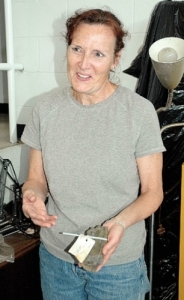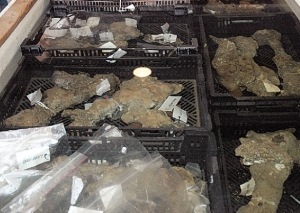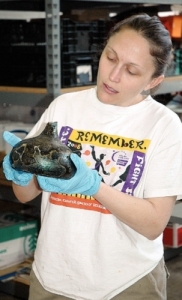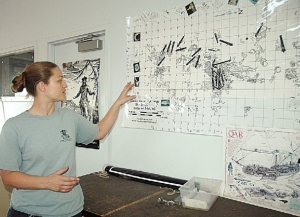Williams helps to save the 'Queen'
By Catharin Shepard
Published in News on April 12, 2010 1:46 PM

News-Argus/MOLLY FLURRY
Wayne County Museum Director Terry Williams holds a piece of concretion from which she tediously extracted several pieces of munitions while working as a lab technician on the Queen Anne's Revenge restoration project. Ms. Williams is a trained conservator who is helping as lab technician at the Queen Anne's Revenge restoration site.

News-Argus/MOLLY FLURRY
Baskets hold concretions, the solid masses of mineral and organic buildup created from years of wreckage lying on the ocean floor. The concretions are resting in a solution especially designed to break down the concretion to reveal artifacts.

News-Argus/MOLLY FLURRY
Shanna Davis handles a glass onion-shaped jar likely used to hold wine or rum which was excavated from the ship's wreckage. Davishad to remove concretion and more than 300 years of organic buildup to restore the bottle.

News-Argus/MOLLY FLURRY
Wendy Welsh talks about the process of excavating the ship researchers are working to prove is indeed Blackbeard's Queen Anne's Revenge off the coast of Beaufort.
GREENVILLE -- The unimpressive lump of brown and gray material in Wayne County Museum Director Terry Williams' hand looked more like a cracked hunk of badly-poured concrete than a clue to a 300-year-old mystery.
It took months to even get the misshapen piece of debris to that point, after it was hauled up from the bottom of the ocean by a team of underwater archaeologists, soaked in a series of solvent baths and finally dissected -- slowly and painfully -- by the trained conservator.
In the end, though, the rock-hard, bland-looking chunk of mineral and rust deposits gave up its treasures: tiny pieces of lead shot made to fit 18th-century weapons.
Ammunition for the guns, possibly, of the infamous pirate Blackbeard.
Divers exploring the Graveyard of the Atlantic made headlines in 1996 when they located a centuries-old shipwreck near the supposed last known location of Blackbeard's flagship, the Queen Anne's Revenge. According to historical sources, the Queen Anne's Revenge, a former French slave ship originally named La Concorde, sank when Blackbeard tried to enter Beaufort Inlet.
Since that discovery, many dozens of people have dedicated their time and knowledge to reclaiming the remains of the shipwreck from the waves that sank her in 1718. Now the pieces of history are slowly being cleaned up and relocated to the North Carolina Museum of Maritime History in Beaufort, even as historians continue to search for ways to confirm the ship's suspected identity.
Ms. Williams began volunteering part-time as a lab technician for the Queen Anne's Revenge project just a few months ago, not long before she was hired as the new Wayne County Museum director. Since then, she has joined the Queen Anne's Revenge project team in their cavernous warehouse at East Carolina University, getting hands-on with the reality of the long-standing legend.
Ms. Williams is trained in conservation, the art and science of preserving artifacts without damaging them. It's the first time the retired Air Force veteran has had a chance to work on an underwater archaeological project, and the first time she has worked on such a big project, she said.
"I've never done any archaeological stuff before, so that's just really great, learning about the whole process. I had no idea, when I came out for the first visit, what all was out here," Ms. Williams said.
The artifacts dredged up from the shipwreck on the ocean floor are as tiny as the lead shot Ms. Williams uncovered and as large as a seven-foot-long section of the ship's oak hull. Few pieces of the Queen Anne's Revenge were left intact after centuries of water erosion and decay.
When it was new, the ship would have more than filled the warehouse where the conservation process is under way, QAR conservator Wendy Welsh said. Today, the ship that may have once terrorized the Caribbean has been reduced to just two splintered segments, resting in a mild chemical solution to keep it from warping and falling apart when exposed to air.
"They've been sitting in the water for 300 years, they've been encrusted with whatever, and so you have to keep it in that environment so you can actually treat it. You're stabilizing that, and it also allows the salt that was in it to come out," Ms. Williams said about the long, slow process.
The large solvent tanks scattered around the warehouse hold other treasures, such as enormously thick sections of concretions and several of the ship's 25 cannons undergoing electrolysis. The slow process removes the rust and deposits from the metal, preserving it from further damage, although Ms. Williams and the other project workers have to drain and replace the liquid several times a year. A handful of the guns found at the shipwreck have already been cleaned completely and put on display for visitors at the Maritime Museum.
Some of the shipwreck finds are startling in their size and condition, though on first look, they may seem unremarkable. A tiny bone, identified as the ulna of a ship rat, the last bits of a sword or knife hilt and even flakes of gold were among the recovered items. A pewter dinner plate, covered with visible scratches from long-lost eating utensils and even the remains of a glass onion bottle, likely used to hold wine or rum. The researchers have been able to trace some of the dining plates back to their point of origin in Great Britain, thanks to the maker's marks on the cleaned-up plates.
The lead shot that Ms. Williams has worked on recovering tells its own tale. The team is able to x-ray the concretions first, to give Ms. Williams and the other workers a look at what was hiding inside the mystery lump.
"You kind of know when you're going in what's in the different areas," Ms. Williams said.
Even so, working with such small pieces can be nerve-wracking for the team members, and the small fragments are often very fragile.
"You're playing with something 300 years old, and if you mess up, it's gone," Ms. Welsh said.
As Ms. Williams continues her work on the project, she said she hopes to further hone her skills in recovering old artifacts, something that may come in handy in her work with the Wayne County Museum, she said.
Lab technician Myron Rolston said that due to the way the shot was manufactured, it was definitively created before 1769 or 1789, when ammunition making methods changed. So far, all of the artifacts recovered have been dated to have been produced in the years before the Queen Anne's Revenge went down. It is the small details give the research team clues as to whether the remains really are those of Blackbeard's flagship.
"We don't really expect to find anything that says 'Blackbeard was here,'" Ms. Welsh said.
But so far, clues have supported that theory. The number of guns, and the fact that they have been identified as from a mix of makers -- British, French and Swedish -- suggests that whatever the ship was doing when it sank, it was "not on the up and up," Ms. Welsh said.
"It if were a merchant (vessel), no, it would not have had that many cannons," she said.
Another discovery, tiny yellow glass beads, may be related to the Queen Anne's Revenge's history as a former French slave ship. At least one of the beads has been tracked to West Africa, after the researchers were able to identify the specific method used to make the bead. It is possible the beads were related to the slave trade, and may have been left behind when Blackbeard first took the La Concorde, QAR conservator Shanna Daniel said.
Although the wreck happened nearly three centuries ago, the project is now facing a time crunch. The North Carolina Department of Cultural Resources funds the Queen Anne's Revenge project, and budget constraints and cutbacks play a part in how much the project workers can do each year to preserve more of the wreck. In the 15 years since it was discovered, only about 50 percent of the wreck has been excavated. The rest is left to the mercy of the Atlantic Ocean until the team can bring up the rest of the debris.
"We have to pick and choose what we can and can't do," Ms. Welsh said.
But it could be only a matter of time before the next major storm further damages the wreck, erasing what answers the remains might have about a part of North Carolina's history.
In the meantime, Ms. Williams and the team at the QAR project will continue their mission of conserving whatever evidence they can to save a queen.
